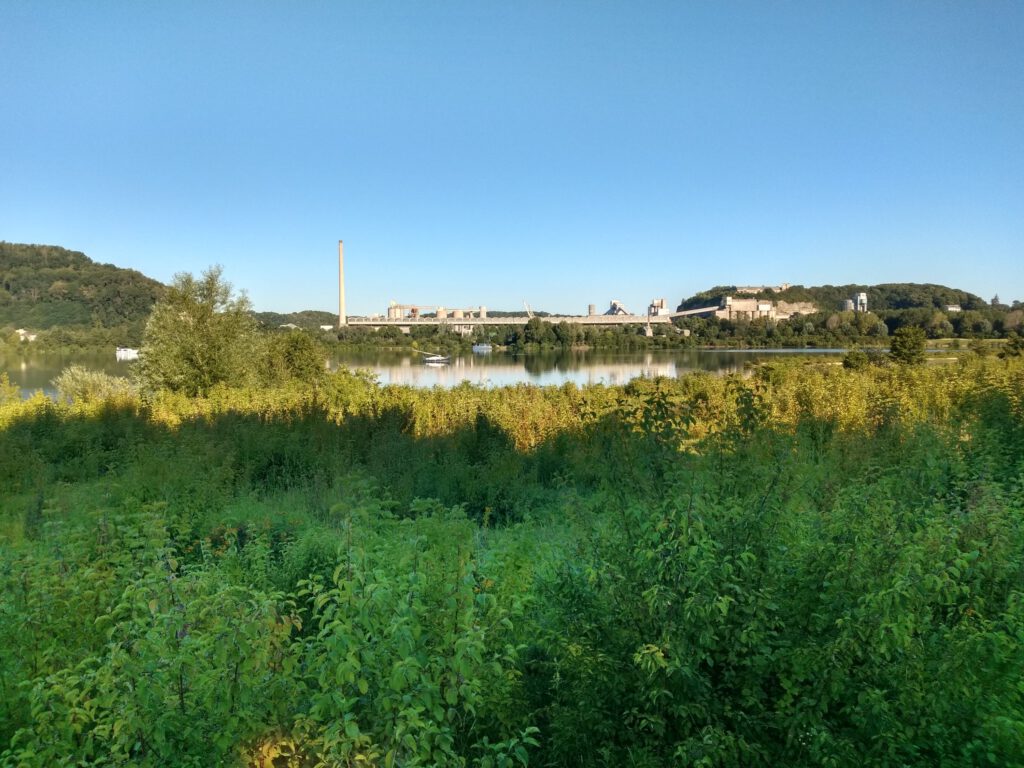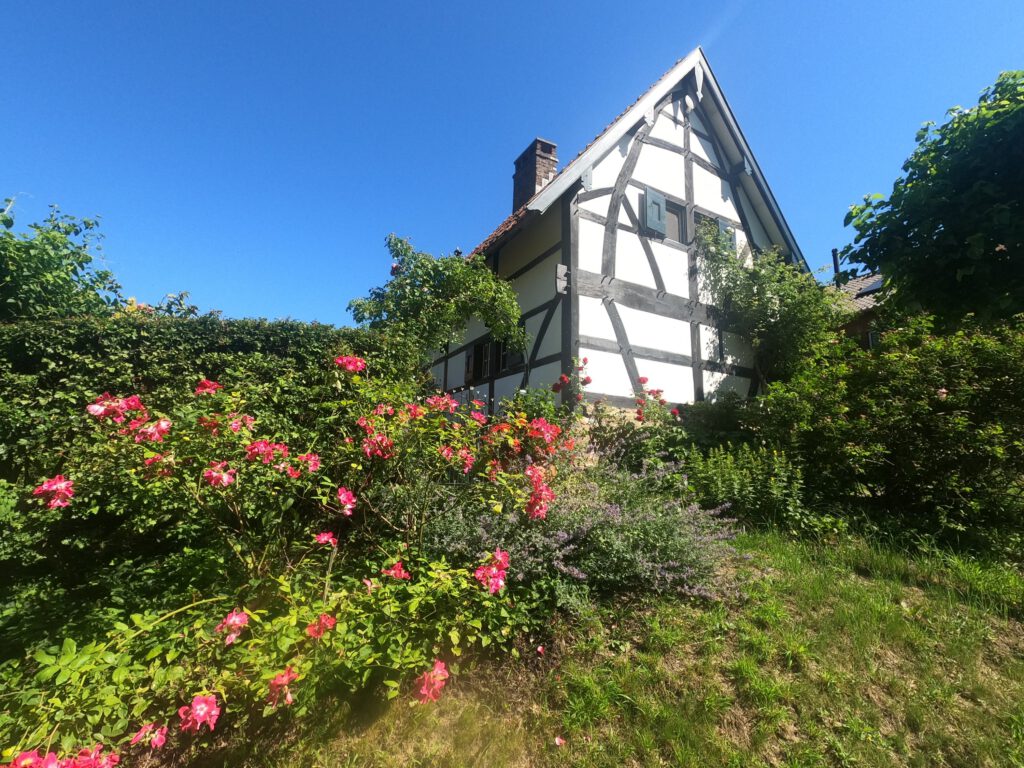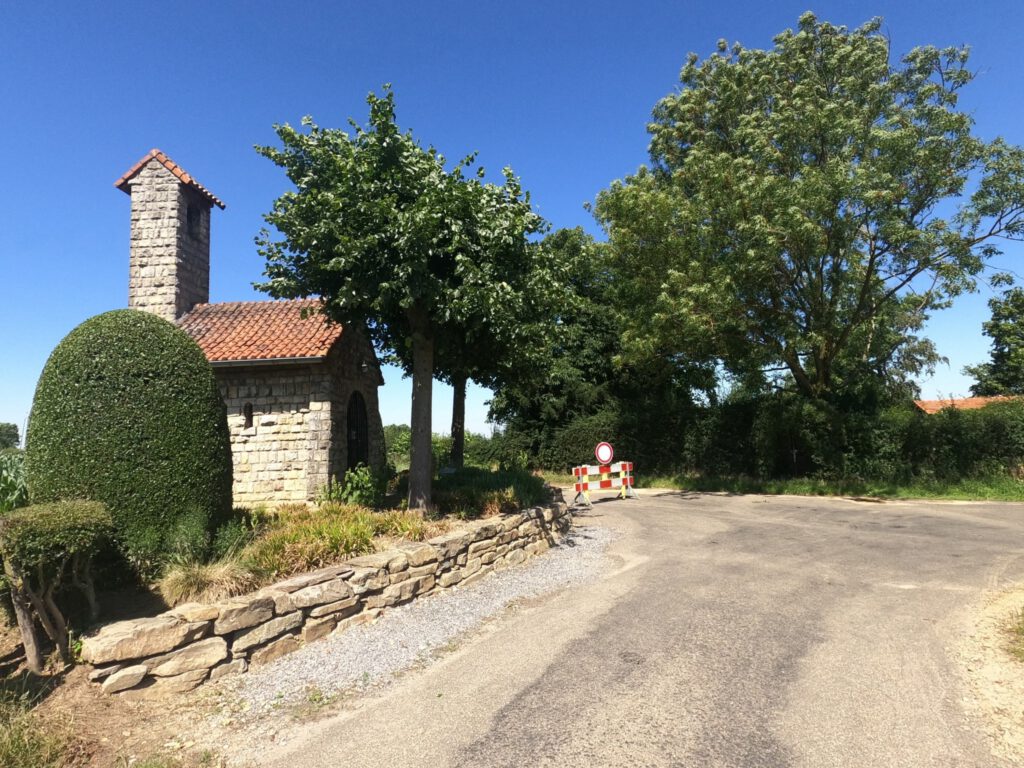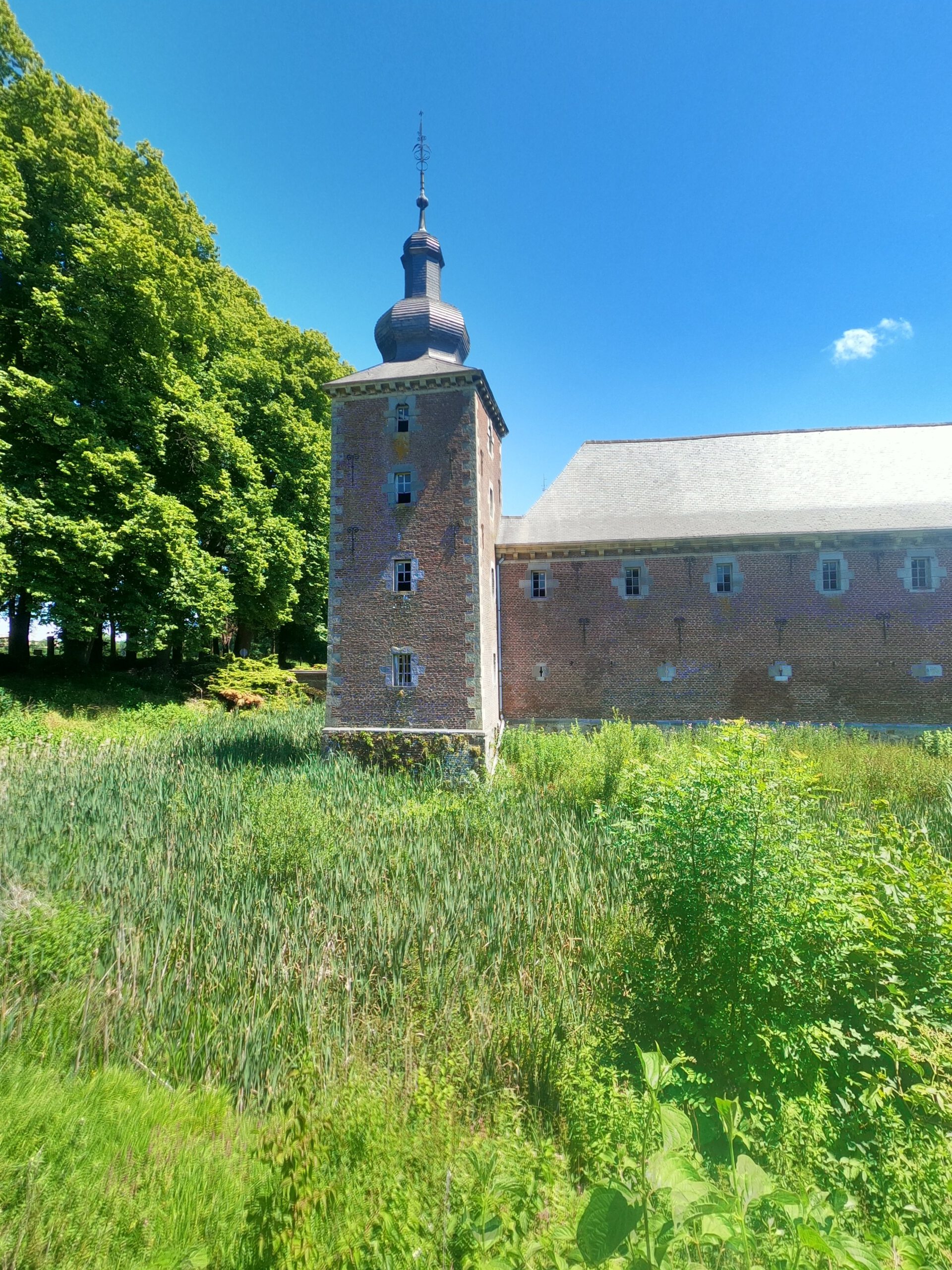
The first stage of my 100 km running on the Krijtlandpad. Does a hard fall in Eijsden mean the end of the trip?
With difficulty I open my eyes at 6 o'clock in the morning. The weather forecast had predicted a warm day, at least 30 °C. And as you may know, Zuid-Limburg is almost the only part of the Netherlands with a continental climate. In other words, it gets warmer in summer than in the rest of the Netherlands and starting out early is recommended. Not only because of the weather by the way, I also wanted to avoid rush hour and I had to take the train to the starting point in Maastricht.
I felt a bit drousy, but ten minutes later I really wasn't t tired anymore. The weeks before I was a bit worried about the temperature and about running long distances for three consecutive days. But today I felt calm and up to the challenge. I had nothing to loose, no speed records to break. And in case it should go wrong: I came through many places with good public transport connections. The mandatory face mask for public transport went along anyway because of travelling between Valkenburg, start and finish.
By the way, I used that first hour of getting up quite fully. First I made a cup of coffee to help empty the bowels. Then I ate breakfast with a few units less insulin and made the drinking solutions for the day: for during the run 2 Ucan solutions in a soft flask and 2 fast sports drinks (Isostar and Hammer Heed) and just before departure 1 Ucan as a solid foundation. In total, I had no less than 4 litres of drinks with me on the way, while there was already half a litre of Ucan, coffee and cornflakes in the tank.
Cement
The route starts at the railway station of Maastricht. For a moment I consider making a selfie with the station clock, like with the NS-MST-routes, but I realize that this is quite useless: at the end of the route there is no station for the second clock picture. So I go straight on to the river Maas, the river that accompanies me the first kilometers of the trip.
I had already bought the booklet of the Krijtlandpad, but I hadn't really, um, read it yet. So somewhere I had the silent hope to walk through the former quarry of the ENCI, which is now a very beautiful nature reserve. However, after a few kilometers I passed the ENCI building from a great distance, which I found very unfortunate.
In 2006 I was on a tour of the quarry when it was still in operation toegether with its large kiln for the cement. Preceding that there was a surreal meeting of the magazine for concrete constructions (Cement) for which I was editor at the time. The activity in Maastricht had already been scaled down to such an extent that we didn't have to reserve a room for the meeting. ‘Just pick a floor’, was the simple answer. And of course the meeting included the traditional Limburg flan. Cherries if I remember correctly.
The atmosphere at ENCI, in the main building in Den Bosch where I worked two days a week, and in Maastricht was actually always good. My mind automatically went back to those days. I preferred ENCI over the actual boss, the small publishing house Aeneas in Boxtel, where three quarters of the staff left in the 9 months that I worked there. Because of that restlessness and as I got better opportunities in my great love, chemistry, I quickly stopped working there. So this northerner never attended the carnival in Den Bosch. How the name on a facade can put you in a nostalgic mood.
Clumped together
My trip along the river was very slow. The temperature was still pretty good (I started at 24 °C), but the blood sugar dropped completely after a few km. Despite the half litre of Ucan, which normally provides stability. Despite the long time – three quarters of an hour – since breakfast which usually means starting high, which is not nice either. Every few kilometers extra fuel was needed. Totally unexpected for me. And also very tiring.
Meanwhile it was getting warmer and warmer (33 °C on stop tour) and I still ran in full view of the sun next to a river. Heat also tends to disrupt the blood sugars. The insulin is absorbed better and the cooling system simply devours energy just like an air-conditioning system craves electricity. This problem could last the whole route.
The heat was also evident in the Eijsder Beemden. This area should be full of large cattle and Konik horses. Normally these are very photogenic. Today they preferred to stay in the shade as much as possible. In the meantime I was happy with my cap that cast shadow over the face. This made it feel a few degrees cooler compared to running without it.
Di(e)pstraat
After about 12 kilometres I was quite tired when I ran through the village of Eijsden. There was work on the road, so my route was closed. Pity. I checked my watch and thought that I could easily navigate around it. Tried to get something to eat. Greeted a road worker. And started running again. Suddenly I felt like flying through the air and fending my body, before hitting the brand-new Diepstraat with its sharp and odd pavement – looks nice, lands shitty – with a bang. Apparently I had overlooked a protruding drainage hose. Dazed I stayed down for a while. My watch was more than a meter in front of me with only a strap on one side. My right arm hurt enormously and bled. My left shoulder was bleeding. My left upper leg and ribcage felt as if I had been hit by a truck; even breathing was painful.
The just greeted road worker came to me in shock and asked if I could get up. He was very helpful. I took the time to feel if everything was still working and stood up slowly. That was a bit more blood than expected, so I grabbed my medical kit from the racing vest (not without scratches either). The road worker got a water hose to clean the wounds on my arm. Whew, that stung. But I had to stay strong and should not sit down if I wanted to finish this trip.
Naturally, the tape to attach the bandage could not be found (found it at the bottom of the vest afterwards). Luckily the 1.5 m was not maintained strictly and I was allowed to use the first aid in the construction shed. But I could not leave withou solving some confusion: where was the other half of my watch band? Luckily the glass was still in one piece and the case only had a few scratches, so navigating would still go if I could fix the watch again. Maybe there was a running shop around here somewhere? How could I go on like this? Tape it down? For three days? Not very coherent thoughts, but the fall was harder than the watch suggested. My wrist even showed clear marks of where that case had cut into the flesh.
No matter how hard we looked, no strap. So we had to go to the hut for the bandage. I even got the compliment that I looked like a pro runner. And I think they were seriously surprised that I wanted to move on so quickly to avoid muscle aches and pains. I had to, as those could be the end of my whole trip. After recovering for a while – and I think I also got the blood sugar a bit higher again with adrenaline – I came back to my senses again. The watchstrap wasn't torn or torn away, it just appeared to be the quick release that jumped loose. You might say it functioned as the ejection seat of the Fenix. After snapping it in place, everything was fine again. My little tank.
It's also funny that people seem more willing to help you when they see the blood sugar sensor on your arm. Probably the consider it less of a stupid action. At Maastricht station, the sensor also helped me to find a bit more space to inject insulin when all the toilets were occupied.
White shepherd
During running, the pain in my left upper leg was especially annoying. I saw that on the tights some wires had been scraped away. Luckily I was always a bit exhibitionistic. Even my Nutritape racing plaster was completely crumpled on that side. But most of all I had another dilemma: how do I tell this to Franny without being allowed to run on my own.
It may sound stupid, but somehow I always find it scary what others think when you run long distances with diabetes while being completely self supporting.
Of course, in everyday life, I also save myself. But exertion makes it more difficult to keep everything under control, with all the risk of accidents that entails. I have already proven that I am clumsy a few times last year. A hard fall in lava rock on Lanzarote and one in the sand during the Airborne Freedom Trail. Still, I'm sure I can manage on my own. But do others know or believe that?
A kilometre or two after the fall I met a white shepherd. They are quite rare and that is why I immediately think of Ashanti, Ramona's dog. It cheered me up again. ‘Stop the chatter and keep going.’ Good advice.
Timber frambing
That tastes like Mheer (read Mhore). It could only be the slogan of this little village. It has a beautiful Maria chapel, a steep slope and timber framed houses. The first one I really take in in this region. As a child I often went on holiday to Germany with my parents, and there was one thing my father always loved: half-timbered houses. Kitschy, cozy and nostalgic.
Via Mheer en Noorbeek – a place that hasn't changed in the past centuries and one you should not skip (read too late) – I arrive in Slenaken. Time for reflection, because Slenaken is actually the end point of the first two official stages of the Krijtlandpad. In the original plan I would cross here to Gulpen, which in terms of public transport is better connected to Valkenburg. And it is also a route that according to some people offers the most beautiful part of the Krijtlandpad. But how did the body feel?
Yeah, I was tired. But despite the setbacks I actually enjoyed the landscape and the running itself to the fullest. It didn't go fast. But there was no need for that either. At this pace I would reach Gulpen between 13 and 14 hours. Not crazy in terms of lunchtime. Because the hypo’s stayed on it might have been a bit more like walking and applying sunscreen at ease. But the legs felt good and the bruises were no obstacle. After admiring the Slenaken church for a while (and apparently setting the fifth time on the stage KLP Mariadorp-Slenaken) I turned to Gulpen.
Stream
On Komoot's map the route from Slenaken to Gulpen was marked as a river path. So I was a bit surprised that on some stretches this little river was hardly an arm wide. Yet it already existed in Roman times. The name Gulp probably comes from Gulipa, which means small gully or upper brook. Despite the fact that it is such a small stream, it does flow fast, so there are many watermills along the banks.
The last few kilometres the energy had left my body almost completely. Again: hypos. I should have been close to Gulpen by now, but I hadn't seen that abandoned castle before. And that's strange for a castle that was built in 1288 and is only a mile from the city center of Gulpen.
The castle is called Neubourg and appears to be privately owned. Because of the fences it looks as if it has been empty for centuries. Sneakily I started dreaming what it would look like to live there, in the middle of the hills and fields. In 1992 the last inhabitant, the countess Rudolf de Marchant et d’Ansembourg died. Since then, due to all kinds of disagreements about the restoration – started almost immediately after her death – the castle was left alone. Unbelievable that in 1992 a countess still lived there, who lived in a slowed down environment. purportedly she saw the demolition of every branch on the estate as the loss of a loved one. Unbelievable too that after her death all valuables, portraits, library and silver disappeared to the many family members and auction houses.
Also slowing down, I walked the last 1.5 km. In Gulpen I enjoyed the local stewed meat and chips on a terrace. The fall didn't bother me anymore, tomorrow was still far away. Living in the now.
Done: distance 37.9 km, 492 altimeters, time 6 hours, 5 minutes and 2 seconds.






























2 Replies to “Krijtlandpad: Maastricht-Slenaken-Gulpen – eerste etappe”
Comments are closed.